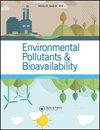保护环境:化学形态和生物利用度的观点
Q3 Chemical Engineering
引用次数: 1
摘要
自然环境是生命的中心,为生态系统和社会提供必要的支持。维护我们赖以生存的环境的安全和可持续性是我们的责任。然而,许多人类活动往往对自然环境造成不良影响。人为来源的化学物质已经无意或有意地释放到自然环境中。因此,至关重要的是,我们必须吸取过去的教训,并进一步了解这些化学品对环境的命运和影响。《化学形态与生物利用度》是一本同行评议的学术期刊,涵盖环境科学和污染的研究,旨在提高环境的安全性和可持续性。最近,Taylor & Francis接管了《化学物种形成与生物利用度》的出版,并邀请我们担任该杂志的共同编辑。我们感到非常荣幸,高兴地接受了这些职位。我们非常清楚未来的挑战,但也珍惜这次共同努力促进化学和环境科学研究的大好机会。我们两人都有环境化学方面的教育和研究背景,对环境命运、运输和化学污染物的影响有着长期的研究兴趣。我们相信,我们之前的经验和共同的兴趣将对我们作为期刊的共同编辑非常有帮助。我们设想,《化学形态与生物利用度》将继续作为一个论坛,为国际研究界提供关于物质在环境和生物群中的发生、分布、运输、转化、转移、命运和影响的化学方面的见解,以及它们对生物吸收这些物质的影响。虽然人为和自然来源的化学品对环境的影响是本刊感兴趣的,但我们特别欢迎提交关于新兴污染物的原始研究,评论和交流,例如工程纳米材料和新兴关注的化学品(即药品和个人护理产品)。《化学形态与生物利用度》的完整目标和范围可以在该杂志的主页上找到,同时还有提交说明和最新文章供查看或下载。期刊的质量将在很大程度上取决于同行评审过程的严谨性,以批评和提高研究质量,并改善作品的展示和可读性。我们非常感谢化学形态与生物利用度审稿人的工作和努力,他们自愿付出时间并分享他们的专业知识。我们指望你保持杂志的高水准。对于作者来说,该期刊将保持其质量和影响力,从而使其成为一个更有吸引力的发表您的原创研究论文、简短交流、评论文章、观点/评论/政策更新、书评和信件的场所。对于读者来说,《化学形态与生物利用度》将继续从化学形态和生物利用度的角度推进我们对化学物质在环境中的命运和影响的理解。最后,我们还要感谢以前的编辑和编辑委员会成员对期刊的贡献。你的远见卓识和辛勤工作使我们的工作轻松多了。我们希望您喜欢阅读这本杂志,我们期待着与您分享关于化学物种形成和生物利用度的新研究。本文章由计算机程序翻译,如有差异,请以英文原文为准。
Keep the environment safe: the viewpoints of chemical speciation and bioavailability
The natural environment is central to life and provides essential support to the ecosystem and to society. It is our responsibility to maintain the safety and sustainability of the environment upon which we depend. However, many human activates have often resulted in undesirable impacts on the natural environment. Chemicals of anthropogenic sources have been released into the natural environment, both unintentionally and deliberately. Thus, it is crucial that we learn the lessons of the past, as well as advance current knowledge of the fate and impacts of these chemicals on the environment. Chemical Speciation & Bioavailability is a scholarly peer-reviewed journal that covers research in environmental science and pollution, with the aim of improving environmental safety and sustainability. Recently, Taylor & Francis took over the publication of Chemical Speciation & Bioavailability and invited us to serve as coeditors of the journal. We felt very honoured and gladly accepted these positions. We are very much aware of the challenges ahead, but also cherish this great opportunity to work together to promote research in chemistry and environmental science. Both of us have educational and research backgrounds in environmental chemistry and long-standing research interests in environmental fate, transport and the impacts of chemical pollutants. We believe that our previous experiences and shared interests will be very helpful for us as co-editors of the journal. We envision that Chemical Speciation & Bioavailability will continue to serve the international research community as a forum for insights on the chemical aspects of occurrence, distribution, transport, transformation, transfer, fate and the effects of substances in the environment and biota, and their impacts on the uptake of these substances by living organisms. Whilst the environmental impacts of chemicals from anthropogenic and natural sources are of interest to the journal, we especially welcome submissions of original research, reviews and communications on emerging contaminants, such as engineered nanomaterials and chemicals of emerging concerns (i.e. pharmaceuticals and personal care products). The full aims and scope of Chemical Speciation & Bioavailability can be found on the journal’s homepage, along with submission instructions and latest articles for viewing or download. The quality of the journal will strongly depend on the rigorousness of the peer-review processes to both critique and improve the quality of the research and to improve the presentation and readability of the work. We really appreciate the work and efforts of the referees for Chemical Speciation & Bioavailability, who volunteer their time and share their expertise. We are counting on you to maintain the high standards of the journal. For authors, the journal will retain its quality and impact, thus making it a more attractive venue to publish your original research papers, short communications, review articles, perspectives/commentaries/policy updates, book reviews and letters. And for the readers, Chemical Speciation & Bioavailability will continue to advance our understanding of the fate and impacts of chemical substances in the environment from the viewpoints of chemical speciation and bioavailability. Finally, we also want to thank the previous editors and editorial board members for their contributions to the journal. Your great vision and hard work has made our job much easier. We hope that you enjoy reading the journal and we look forward to sharing novel research with you on chemical speciation and bioavailability.
求助全文
通过发布文献求助,成功后即可免费获取论文全文。
去求助
来源期刊
CiteScore
1.62
自引率
0.00%
发文量
0
审稿时长
1 months
期刊介绍:
Chemical Speciation & Bioavailability ( CS&B) is a scholarly, peer-reviewed forum for insights on the chemical aspects of occurrence, distribution, transport, transformation, transfer, fate, and effects of substances in the environment and biota, and their impacts on the uptake of the substances by living organisms. Substances of interests include both beneficial and toxic ones, especially nutrients, heavy metals, persistent organic pollutants, and emerging contaminants, such as engineered nanomaterials, as well as pharmaceuticals and personal-care products as pollutants. It is the aim of this Journal to develop an international community of experienced colleagues to promote the research, discussion, review, and spread of information on chemical speciation and bioavailability, which is a topic of interest to researchers in many disciplines, including environmental, chemical, biological, food, medical, toxicology, and health sciences.
Key themes in the scope of the Journal include, but are not limited to, the following “6Ms”:
Methods for speciation analysis and the evaluation of bioavailability, especially the development, validation, and application of novel methods and techniques.
Media that sustain the processes of release, distribution, transformation, and transfer of chemical speciation; of particular interest are emerging contaminants, such as engineered nanomaterials, pharmaceuticals, and personal-care products.
Mobility of substance species in environment and biota, either spatially or temporally.
Matters that influence the chemical speciation and bioavailability, mainly environmentally relevant conditions.
Mechanisms that govern the transport, transformation, transfer, and fate of chemical speciation in the environment, and the biouptake of substances.
Models for the simulation of chemical speciation and bioavailability, and for the prediction of toxicity.
Chemical Speciation & Bioavailability is a fully open access journal. This means all submitted articles will, if accepted, be available for anyone to read, anywhere, at any time. immediately on publication. There are no charges for submission to this journal.

 求助内容:
求助内容: 应助结果提醒方式:
应助结果提醒方式:


